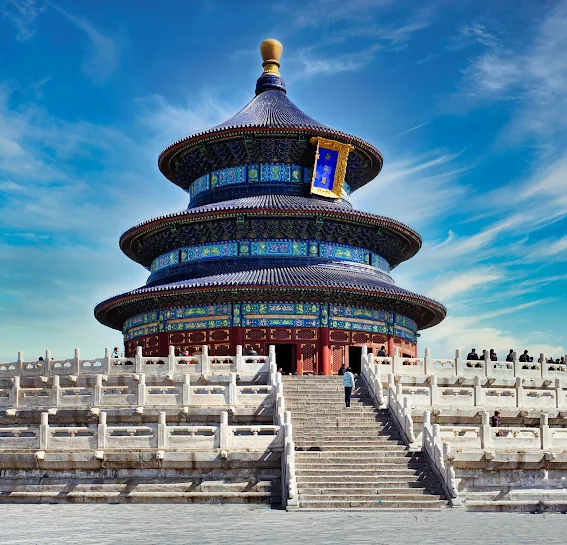The Temple of Heaven
The Temple of Heaven (天坛) is a remarkable architectural and cultural landmark in Beijing, originally constructed in 1420 during the Ming Dynasty. It served as the place where emperors of the Ming and Qing dynasties conducted ceremonies to pray for good harvests and offer sacrifices to Heaven. As the largest and most well-preserved ancient sacrificial complex in China, the Temple of Heaven holds immense historical, cultural, and architectural significance.
The complex covers an area of over 2.7 million square meters and is made up of several key structures, with the Hall of Prayer for Good Harvests (祈年殿) being the most iconic. This circular, wooden structure was built without the use of nails, showcasing the incredible craftsmanship of ancient Chinese architecture. Its design reflects traditional Chinese cosmology, with the number three symbolizing Heaven, Earth, and humanity, and the circular shape representing Heaven, while the square base signifies Earth.
One of the most fascinating aspects of the Temple of Heaven is the intricate use of acoustics in its design. The Echo Wall (回音壁) is a circular wall that allows sounds to travel along its curve. A whisper spoken at one point of the wall can be clearly heard at the opposite end, demonstrating the ancient Chinese understanding of sound dynamics. Similarly, the Triple Sound Stone (三音石) and Dialog Stones (对话石) within the complex are clever architectural features that use acoustic principles to create unique sound effects, further emphasizing the sophistication of the construction techniques employed during the Ming and Qing eras.
The Temple of Heaven complex was not only an important religious site for the emperors, but also a symbol of the emperor’s role as the intermediary between Heaven and Earth, a key element of traditional Chinese thought. The ceremonies held here were believed to ensure the harmony between Heaven and Earth, which was essential for the prosperity and stability of the empire.
In 1998, the Temple of Heaven was inscribed as a UNESCO World Heritage Site, recognizing it as a masterpiece of Chinese architecture and a representation of traditional Chinese cosmology and ritual practices. It is also one of the best-preserved and most influential examples of religious architecture from the Ming and Qing periods.
Visitors to the Temple of Heaven today can explore its beautiful park, enjoy the serene environment, and marvel at the historical significance of the structures within. The park is not only a site of immense historical importance but also a popular destination for both locals and tourists, offering space for recreation, cultural activities, and a deep connection to China’s rich imperial past.
Website: http://www.tiantanpark.com/english/
Recommended visiting time: 1-2 hours
ZJourney:
We are excited to introduce ZJourney to China, an AI-driven self-service platform specifically designed for foreigners traveling to China. The platform will provide you with convenient travel information and services. It will be launching soon, and we invite you to leave your email address so that we can notify you when it is live and offer you a chance to try it!

